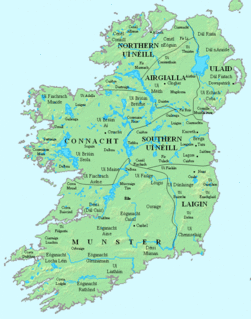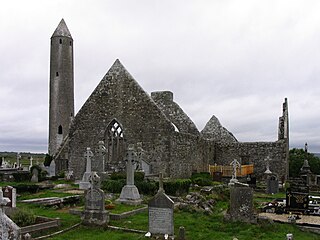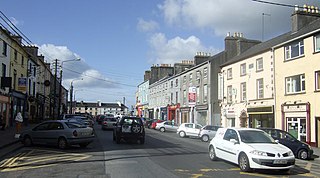
Cenél Áeda na hEchtge (also Cenél Áeda, Kenloth, Kinalethes, Kenealea, Kinelea) was a trícha cét (later a cantred, (a branch of the Uí Fiachrach Aidhne) and which was the original formation of the southern part of the barony of Kiltartan, County Galway. This was the clan name of the O Shaughnessys and O Cahills who both ruled the territory until the O Cahills were forced from the area by the O Shaughnessys. The latter remained chiefs of the area until 1691 and the head family survived in the Gort area till the demise of the senior line in the 18th century. The name was taken after the cenél (kindred) of Aedh, uncle to King Guaire Aidne mac Colmáin of Connacht (died 663).
The tríocha céad, also known as trícha cét, meaning "thirty hundreds", was a unit of land-holding in eleventh and twelfth century Ireland. The term appears to relate to the number of troops an area could raise.
A cantred was a subdivision of a county in the Anglo-Norman Lordship of Ireland between the 13th and 15th centuries, analogous to the cantref of Wales or the hundred of England. In County Dublin the equivalent unit was termed a serjeanty, while in County Meath and environs it was a barony. The area of a cantred usually corresponded to that of an earlier trícha cét of Gaelic Ireland, and sometimes to that of a rural deanery in the medieval Irish church. Paul Mac Cotter has "demonstrated the existence of 151 certain cantreds and indicated the probable existence of a further 34." Cantreds were replaced by baronies from the 16th century.

Uí Fhiachrach Aidhne was a kingdom located in what is now the south of County Galway.
Contents
It consisted of what are now the parishes of Beagh, Kilbecanty, Kilmacduagh, Kiltartan, Kilthomas (now Peterswell).

Kilmacduagh is a small village in south County Galway, near Gort, in Ireland. It is best known for Kilmacduagh monastery, seat of the Diocese of that name. The diocese is now part of the Diocese of Galway and Kilmacduagh in the Roman Catholic Church and in the Diocese of Limerick and Killaloe in the Church of Ireland. The former cathedral is now a ruin.
Kiltartan is a barony and civil parish in County Galway, Ireland. The southern portion of this barony was formerly known as Cenél Áeda na hEchtge or O'Shaughnessy's Country, the northern portion was called Coill Ua bhFiachrach and the eastern part was called Oireacht Réamoinn. It was the home of Lady Gregory, Edward Martyn, and a regular residence of W.B. Yeats. The barony takes its name from the Burke stronghold of Kiltartan Castle also known as Castletown or Ballycastle. The castle in turn takes its name from the medieval church of Kiltartan a short distance to the north. The original Irish name for the church and parish was Cill Athrachta which was corrupted to Cill Tortain. The older anglicised form was Kiltaraght which is closer to the original Irish form.
The Uí Fiachrach Aidhne originally kings of all Connacht (modern province of Connacht with all of County Clare and parts of County Limerick - see Thomond) by the late 8th century they were largely reduced to their home territory i.e. the area of the later Kilmacduagh diocese.

Connacht, formerly spelled Connaught, is one of the provinces of Ireland, in the west of the country. Up to the 9th century it consisted of several independent major kingdoms.

County Clare is a county in Ireland, in the Mid-West Region and the province of Munster, bordered on the West by the Atlantic Ocean. There is debate whether it should be historically considered a part of Connacht. Clare County Council is the local authority. The county had a population of 118,817 at the 2016 census. The county town and largest settlement is Ennis.

County Limerick is a county in Ireland. It is located in the province of Munster, and is also part of the Mid-West Region. It is named after the city of Limerick. Limerick City and County Council is the local council for the county. The county's population at the 2016 census was 194,899 of whom 94,192 lived in Limerick City, the county capital.
Another trícha in the area was Cenél Guaire, named after Guaire Aidne mac Colmáin.
Guaire Aidne mac Colmáin was a king of Connacht. A member of the Ui Fiachrach Aidhne and son of king Colmán mac Cobthaig. Guaire ruled at the height of Ui Fiachrach Aidne power in south Connacht.
The word Echtge refers to the Slieve Aughty, beside which it was located.
The Slieve Aughty are a mountain range in the western part of Ireland spread over both County Galway and County Clare. The highest peak in the Slieve Aughty Mountains is Maghera in Clare which rises to 400m (1,314ft). The mountain range consists of two ridges divided by the Owendallaigh river which flows west into Lough Cutra.




